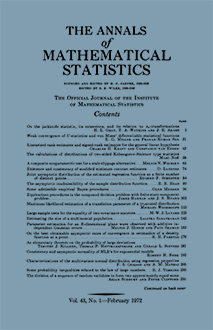Abstract
A problem that seems to be of some practical interest is that of comparing $k$ experimental categories with a standard (or control) in order to determine if any of the experimental categories are better than the standard (or control) and if so, to find the best one. We might for example be concerned with evaluating several new drugs in relation to a placebo, or with evaluating several new alloys in relation to some standard alloy. This problem has been discussed in the non-sequential case in [1] and [2]. In the present paper we will be concerned with a sequential treatment of the problem. In our notation, the subscript 0 will always refer to the standard (or control), the subscript $i$ will range from 0 to $k$, and the subscript $j$ will range from 1 to $k$. Let $X_i$ be the random variable resulting from a measurement with the $i$th category $\pi_i$. We will assume the probability distribution of $X_i$ is the same for each $i$ except for a single parameter $\theta$, which might vary from category to category. The probability density of $X_i$ (or the probability of $X_i = x$ in the discrete case) will be denoted by $f(x, \theta_i)$ and this is assumed known, except for the value of $\theta_i$. For simplicity, we will suppose that the larger the value of $\theta$, the more desirable a category is. Let $R_0$ denote the relation $\theta_1 = \theta_2 = \cdots = \theta_k = \theta_0$, and let $R_j$ denote the relation $\theta_1 = \cdots = \theta_{j-1} = \theta_{j+1} = \cdots = \theta_k = \theta_0$ and $\theta_j = \theta_0 + \Delta$, where $\Delta > 0$. Let $D_0$ denote the decision that none of the experimental categories is better than the standard (or control) $\lbrack\text{that is}, \theta_s \leqq \theta_0$ for $s = 1, 2, \cdots, k\rbrack$ and let $D_j$ denote the decision that $\pi_j$ is the best experimental category and is better than the standard $\lbrack \text{that is}, \theta_j = \max (\theta_1, \theta_2, \cdots, \theta_k) > \theta_0\rbrack$. We will develop a sequential procedure for choosing one of the $k + 1$ decisions $(D_0, D_1, \cdots, D_k)$ so that the probability of selecting $D_0$ when $R_0$ is true is $\geqq 1 - \alpha$, and the probability of selecting $D_j$ when $R_j$ is true is $\geqq 1 - \beta$ for each $j, j = 1, 2, \cdots, k$. First we will treat the case where $\theta_0$ is known and $f(x, \theta)$ is arbitrary, and then consider the case where $\theta_0$ is unknown and $f(x, \theta) = (2\pi\sigma^2)^-\frac{1}{2}\exp \lbrack\frac-{1}{2}(x - \theta)^2/\sigma^2\rbrack$. A rather interesting feature of the sequential procedures that are developed is that inferior categories can be eliminated before the final stage of the experiment, which tends to decrease the number of measurements required to reach a decision. An investigation is made (when $\theta_0$ is known) of the efficiency of the sequential procedure when compared with the corresponding "best" non-sequential procedure, which indicates that a substantial saving in the average number of measurements required to reach a decision is possible with the sequential procedure.
Citation
Edward Paulson. "A Sequential Procedure for Comparing Several Experimental Categories with a Standard or Control." Ann. Math. Statist. 33 (2) 438 - 443, June, 1962. https://doi.org/10.1214/aoms/1177704570
Information





